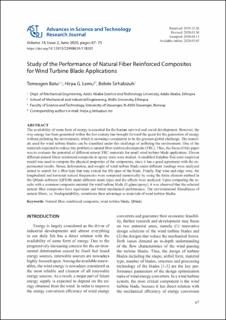| dc.contributor.author | Batu, Temesgen | |
| dc.contributor.author | Sirabizuh, Belete | |
| dc.contributor.author | Lemu, Hirpa G. | |
| dc.date.accessioned | 2023-02-08T08:16:41Z | |
| dc.date.available | 2023-02-08T08:16:41Z | |
| dc.date.created | 2020-07-20T20:36:39Z | |
| dc.date.issued | 2020 | |
| dc.identifier.citation | Batu, T., Lemu, H. G., & Sirhabizuh, B. (2020). Study of the performance of natural fiber reinforced composites for wind turbine blade applications. Advances in Science and Technology Research Journal, 14(2), 67-75. | en_US |
| dc.identifier.issn | 2299-8624 | |
| dc.identifier.uri | https://hdl.handle.net/11250/3049101 | |
| dc.description.abstract | Availability of some form of energy is essential for human survival and social development. However, the way energy has been generated within the last century has brought forward the quest for generation of energy without polluting the environment, which is nowadays considered to be the biggest global challenge. The materials used for wind turbine blades can be classified under this challenge of polluting the environment. One of the materials expected to reduce this problem is natural fiber reinforced composite (FRC). Thus, the focus of this paper is to evaluate the potential of different natural FRC materials for small wind turbine blade application. Eleven different natural fibers reinforced composite in epoxy resin are studied. The modified Halphin-Tsai semi-empirical model has been used to compute the physical properties of the composites, since it has a good agreement with experimental results. Stress, deformation, and weight of wind turbine blade under different loadings are analyzed aimed to search for a fiber type that may extend the life span of the blade. Finally, flap wise, edge wise, longitudinal and torsional natural frequencies are computed numerically by using finite element method in Qblade software (QFEM) under different mode types and the effects are analysed. Upon comparing the results with a common composite material for wind turbine blade (E-glass/epoxy), it has been observed that the selected natural fiber composites have equivalent and better mechanical performance. The environmental friendliness of natural fibers, i.e. biodegradability, comes as a plus to their advantage as materials of wind turbine blades. | en_US |
| dc.language.iso | eng | en_US |
| dc.publisher | Lublin University of Technology | en_US |
| dc.rights | Navngivelse 4.0 Internasjonal | * |
| dc.rights.uri | http://creativecommons.org/licenses/by/4.0/deed.no | * |
| dc.title | Study of the Performance of Natural Fiber Reinforced Composites for Wind Turbine Blade Applications | en_US |
| dc.type | Peer reviewed | en_US |
| dc.type | Journal article | en_US |
| dc.description.version | publishedVersion | en_US |
| dc.rights.holder | The authors | en_US |
| dc.subject.nsi | VDP::Teknologi: 500 | en_US |
| dc.source.pagenumber | 67-75 | en_US |
| dc.source.volume | 14 | en_US |
| dc.source.journal | Advances in Science and Technology Research Journal | en_US |
| dc.source.issue | 2 | en_US |
| dc.identifier.doi | 10.12913/22998624/118201 | |
| dc.identifier.cristin | 1819946 | |
| cristin.ispublished | true | |
| cristin.fulltext | original | |
| cristin.qualitycode | 1 | |

